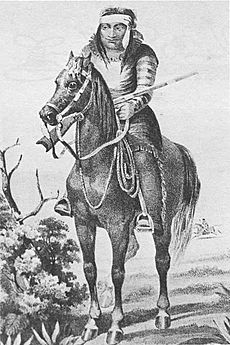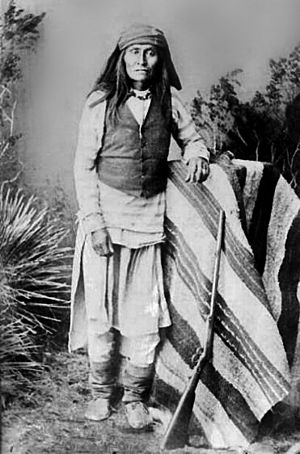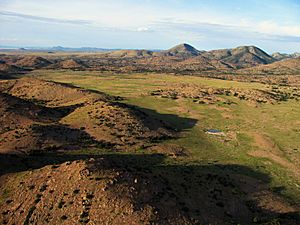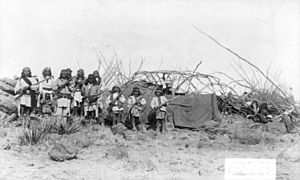Apache–Mexico Wars facts for kids
Quick facts for kids Apache-Mexico Wars |
|||||||
|---|---|---|---|---|---|---|---|
| Part of the Mexican Indian Wars | |||||||
 A camp of the Coyotero Apache in 1873. Brush shelters, called wikiups, were typical, temporary homes for the nomadic Apache. |
|||||||
|
|||||||
| Belligerents | |||||||
(1600s–1716) (1716–1821) (1821–1915) |
Apache | ||||||
The Apache–Mexico Wars were a series of fights between the Apache people and the forces of Spain or Mexico. These conflicts started in the 1600s when Spanish settlers arrived in what is now New Mexico. The fighting between Mexicans and Apache groups was very intense from 1831 to the 1850s. Later, Mexico's actions against the Apache happened at the same time as the Apache Wars in the United States. Mexico continued to fight against some Apache groups until 1915.
Contents
Early Conflicts with the Spanish
The Spanish first met the Apache, who they called Querechos, in 1541 in Texas. At that time, the Apache were nomads who hunted buffalo and traded with the Pueblo people of the Rio Grande valley. Their first meetings were friendly. However, in the 1600s, the relationship between the Spanish and Apache got worse. This was because the Spanish raided for slaves, and the Apache attacked Spanish and Pueblo settlements in New Mexico.
The Apache moved south and west. They were pushed by the Comanche people, who were also moving south. Being forced from the rich buffalo lands of the Great Plains into the dry deserts and mountains likely made the Apache rely more on raiding to survive. By 1692, they were in Chihuahua, Mexico. Soon, they were also in Sonora and Coahuila. They seemed to have joined with other Native American groups in the border area, like the Suma, Manso, Jano, and Jocome.
Chihuahua, Sonora, and Coahuila were more populated and richer than the Spanish colonies in New Mexico. Apache raids quickly became a big problem. In 1737, a Spanish officer said that many mines were destroyed. He also noted that 15 large ranches were completely ruined, losing many animals. Several missions were burned, and 200 Christians died because of the Apache.

Spanish Defenses and Peace Efforts
In the 1770s, Spain tried to solve the Apache problem. They reorganized their border defenses, left some areas, and built a line of presidios (forts) along the northern border. They also launched attacks against the Apache, often with Native American allies. At the same time, they tried to make peace with the Apache.
This chain of 18 forts was about 100 miles (160 km) apart. They were in Sonora, Chihuahua, Texas, New Mexico, and what is now Arizona. These forts were the main defense against Apache raids. In the late 1700s, most forts had 43 soldiers. Larger forts like Santa Fe, New Mexico and San Antonio had 76 soldiers. Janos and San Buenaventura in Chihuahua each had 144 soldiers. The 1,000 soldiers in these forts were helped by local militia and Native American allies. The Presidio San Augustin del Tucson became a very important Spanish settlement in Arizona.
Spanish attacks on the Apache caused many deaths but did not stop the raids. The fighting was most intense from 1771 to 1776. In Chihuahua and Coahuila, 1,674 Spanish people were killed, and 154 were captured. Over 100 ranches were abandoned, and more than 68,000 animals were stolen. Apache groups also suffered many losses. In late 1775, a Spanish military action in New Mexico killed 132 Apache and captured 104.
In 1786, Bernardo de Galvez, the Viceroy in Mexico City, ordered that the war with the Apache should continue. But he also wanted to convince them to make peace. Military actions increased. However, Apache people who gave up and settled near the forts were treated well and given food. Another reason the Apache might have sought peace was that New Mexico had made peace with the Comanche in 1786. The Comanche were now joining the Spanish in fighting the Apache.
By 1790, most Apache groups, who had no single leader, were at peace with the Spanish. By 1793, almost 2,000 Apache had settled at a dozen forts. This included 400 at Janos and 800 at El Norte (El Paso, Texas). The number of Apache still living in the mountains and deserts is unknown. A period of relative peace between the Apache and the Spanish and Mexicans lasted until 1831.
War with Mexico Begins
When Mexico became independent in 1821, the long peace with the Apache started to break down. The number of soldiers at the border forts was reduced. Also, the money for supporting the soldiers and the Apache was cut. A key reason for the new war was that in 1831, the Mexican government stopped giving food to Apache groups settled near the forts. The 2,000 Apache at the forts quickly left. They needed to go back to hunting and gathering to survive.
The military leader of Chihuahua declared war on the Apache on October 16, 1831. He started military actions against them. However, Mexico was not ready for a war against the Apache. The two states most affected, Chihuahua and Sonora, acted almost on their own, separate from the federal government. Sonora (which included Arizona then) had a small population of about 50,000 people. Chihuahua had more people, about 134,000, and a better organized government.
The Apache tribes most involved in the war were the Chiricahua (called "Gileños" by Mexicans) and the Mescalero. These tribes only had about 2,500 to 3,000 people. Neither tribe had one central leader. Instead, they had many independent bands, each with 100 to 500 people. Each band decided on its own whether to be at peace or war with the Mexicans. Bands would often join together for a short time to launch bigger attacks against the Mexicans. But most Apache raids were smaller, with only a few dozen warriors.
The Apache also made separate deals with Mexican states and towns. They would fight some while being at peace with others. Mexico's problem in defeating the fast-moving Apache was made worse by the growing hostility of the Comanche, Kiowa, and Kiowa-Apache. These groups, especially in the 1840s and 1850s, launched large raids with hundreds of men into northeastern Mexico from their safe areas on the Texas plains. (See: Comanche-Mexico Wars)
Apache Raiding Tactics
Apache raids started in 1831. They happened on and off as different bands and leaders, like Juan José Compá (who could read and spoke Spanish), would raid and then respond to peace offers from Mexican officials. Most often, the Apache's goal in a raid was to steal animals and other goods. A common Apache method was to travel on horseback in small groups into Mexico. They would meet with other groups, attack a settlement, kill the men, and capture women, children, and animals. Then they would flee back to their homeland, setting up ambushes along the way to stop anyone chasing them. The Apache avoided big battles unless they had more fighters or could surprise their enemy.
After Mexico became independent, the money and soldiers for the forts decreased. In Sonora, in 1833, the state government asked for public donations to help its defenses. In 1834, they briefly cut the salaries of all state officials by 10 to 33 percent to use the money for more soldiers. In Chihuahua, in 1832, all civilian men were ordered to carry weapons at all times to help the forts. All populated places were ordered to be fortified, and local defense groups were formed. By the early 1840s, Chihuahua had 1,500 soldiers, plus local defense groups. However, much of this force was used to protect the eastern part of the state from Comanches, not to fight the Apache.
Scalp Hunters and Bounties
In 1835, the government of Sonora offered a reward for Apache scalps. Over time, this became a payment of 100 pesos for each scalp of a male aged 14 or older. Later, Chihuahua offered the same reward for males. They also offered 50 pesos for capturing an adult female and 25 pesos for a child under 14. Bounty hunters could also keep any Apache property they captured. The reward for one Apache male was more than many Mexicans and American workers earned in a whole year. It is not clear if these scalp bounties were actually paid in the first few years.
A famous event involved an American named John Johnson. He lived in Sonora and led an expedition against the Apache in April 1837. The Apache had raided near Moctezuma and taken cattle. Johnson gathered 17 Americans and 5 Mexican mule drivers. He got money from the Sonora government and borrowed a small cannon from the fort at Fronteras. This cannon was small enough to be carried by a mule.
Johnson found an Apache camp near the Animas Mountains in New Mexico. Juan José Compá led the group, which Johnson said included 80 men, plus women and children. Johnson and his men attacked the Apache, killing 20, including Compá, and wounding another 20. For this, Johnson received 100 pesos and thanks from the state government. After Compá's death, Mangas Coloradas (Red Sleeves) became the most important Apache leader.

However, attacks like Johnson's made the Apache more angry, not scared. The rich Santa Rita copper mine in New Mexico was a main target for Mangas Coloradas and his followers. In 1838, 22 fur trappers were killed nearby, and the Apache cut off the mine's supply route. The 300 to 400 people living at Santa Rita fled south towards the Janos fort, 150 miles away. But the Apache killed almost all of them on the way. After this, the Santa Rita mine only operated sometimes until 1873. That's when Apache chief Cochise signed a peace agreement with the US, and the mine reopened.
In 1839, the governor of Chihuahua hired an American named James Kirker for 25,000 pesos. Kirker was to raise an army of up to 200 men to fight the Apache. Kirker's second-in-command was a Shawnee Indian named Skybuck. Kirker's men, called "Sahuanos," included Delaware Indians, escaped slaves from the U.S., and also Americans and Mexicans. Kirker's small army seemed to make things worse. They killed friendly Apache or groups who were trying to make peace, which led to more Apache raids. In 1846, Kirker and local Mexicans were responsible for killing 130 peaceful Apaches at Galeana, Chihuahua. Kirker claimed he had followed the trail of stolen animals to the Apache camp.
In 1849, the bounty laws in Chihuahua became more official and stronger. Apache adult male prisoners were worth 250 pesos each. Females and children were worth 150 pesos. Dead Apache adult males were worth 200 pesos, with the scalp given to local governments for proof. That year, the state paid out 17,896 pesos for scalps and prisoners. The law was quickly stopped because it was too expensive. Also, Apache scalps could not be easily told apart from those of other Native Americans or Mexicans.
The attacks by Johnson, Kirker, and the Mexican army did not seem to reduce the number and size of Apache raids.
Impact and Casualties
It is hard to know the exact number of people killed on both sides. However, historian William E. Griffen found enough information to show how widespread the war was in Chihuahua. From 1832 to 1849, there were 1,707 recorded meetings between Native Americans (Apache and Comanche) and Mexicans. In 80 percent of these, fighting happened. Of these, 1,040 were reported to be with Apache groups. The other 667 were with Comanche or other unidentified Native Americans.
There was enough information to count deaths for nine years between 1835 and 1846. A total of 1,394 Mexicans were killed. This included 774 killed by Apache and 620 killed by Comanche or unidentified Native Americans. A total of 559 Native Americans were reported killed. This included 373 Apache and 186 Comanche and unidentified Native Americans. Deaths on both sides included many women and children. More incidents and deaths likely happened but were not recorded.
Deaths from the Apache war in Sonora might have been even higher, though there is less exact data. A Mexican official estimated that 5,000 people in Sonora had died because of the Apache in the 1830s. This seems like a high number, but there were certainly many deaths. The town of Arizpe saw its population drop from 7,000 to 1,500 in a few years. This was because the state capital had to be moved due to Apache attacks. Tucson was attacked several times. Also, 200 people were killed by Apache who got inside the walls of the fort at Fronteras between 1832 and 1849.
It is clear that Mexico's ability to defend itself was greatly weakened by Apache and Comanche raids. This happened at the same time Mexico was dealing with other problems like political instability and American imperialism.
United States Involvement
The U.S. victory in the Mexican–American War and taking over much of northern Mexico in 1848 did not immediately change the war between Mexico and the Apache. Raids into Mexico and the new U.S. territories continued as usual. However, over time, the U.S. took on most of the job of defeating and bringing peace to the Apache. Most Apache groups lived in the United States. Using friendly Apache as scouts to find and fight hostile Apache was a key part of the U.S. success (see Apache scouts).
The last hostile group of Apache, led by Geronimo, surrendered in 1886. However, individual Apache continued to act as bandits in the U.S. and Mexico for many more years (see Apache Wars). This shows how determined and hard to catch the Apache were. Thousands of U.S. and Mexican soldiers and Apache scouts chased Geronimo for over a year, mostly in northern Mexico. Finally, he was convinced to surrender his group, which had only 36 men, women, and children.
Images for kids
See also
 In Spanish: Ataques apaches a México para niños
In Spanish: Ataques apaches a México para niños










